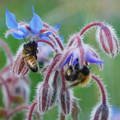How To Grow Aubergines Organically
Aubergines, or eggplants as they're known in the States, are delightful additions to any garden boasting warm summers. When you choose to grow them organically, you're not just ensuring a harvest free of synthetic chemicals; you're actively participating in nurturing a more sustainable environment. This guide will walk you through each step with care, from seed selection to savouring your harvest.
Understanding Aubergines
Before diving into planting, it's essential to understand that aubergines are warm-season crops needing a long growing season. They're a bit sensitive to the cold and require consistent attention. You'll find them in various shapes and colours, from deep, elegant purples to striking whites and even playful striped varieties. Each type brings its unique flair to the garden and kitchen.
Aubergines belong to the same family as peppers and tomatoes and should be grown in much the same manner. They are, however, slightly more cold-sensitive which will halt the plant's growth, reducing its vigour, resistance to pests and disease, as well as its yields. As such, for a successful experience, we recommend growing aubergines under glass only.
Initial Planning and Preparation
Selecting Varieties
Do a bit of research to find varieties that thrive in organic settings and are well-suited to your local climate. Some varieties may be more resistant to pests and diseases, making them ideal for organic cultivation. For example, we recommend the following varieties:
Black Beauty is a classic heirloom variety known for its large, glossy black fruits and prolific yields. It is also relatively resistant to pests and diseases.
Clara F1 is a white aubergine variety that is well-suited for organic cultivation. It is a fast-growing, early variety that produces attractive, glossy white fruits. It is also relatively resistant to pests and diseases.
Pinstripe F1 is another excellent variety of aubergine for organic cultivation. It is a compact, well-branched variety that produces many small, purple and white striped fruits. It is ideal for containers and is relatively resistant to pests and diseases.
Seasonal Timing
Start your seeds indoors about 8-10 weeks before your area's last expected frost date. In the UK this is usually between January and April. This head start is crucial for ensuring that your plants have enough time to mature and produce fruit. The goal is to move your seedlings outdoors when the soil consistently stays above 16°C (60°F), a comfortable temperature for these heat-loving plants. In the UK, sowing outside is possible between April and June.
Starting Seeds Indoors
Creating the Seed-Starting Mix
A good start is half the battle won. Mix equal parts coir, perlite, and vermiculite. This combination ensures good moisture retention while also providing adequate drainage – crucial for healthy root development. Don't forget a handful of worm castings for that extra nutritional boost.
Sowing
Plant your seeds about half a centimetre deep in your prepared trays or pots. Keep the soil moist, but be careful not to overwater, as this can lead to issues like damping off.
Germination Environment
A steady temperature of 21-24°C (70-75°F) is ideal for germination. If you're struggling to maintain this, a heat mat can be a handy investment. Patience is key here – germination can take anywhere from 14 to 21 days.
Post-Germination Care
Once your seedlings make an appearance, reduce the temperature slightly to around 18°C (65°F). This cooler environment encourages stronger, sturdier stem growth. Place on a sunny windowsill or, as we recommend, under LED lights. Remember to start feeding them with a half-strength organic liquid fertiliser every two weeks to support their growth.

A tray of Aubergine ((Solanum melongena cultivar) seedlings growing in a greenhouse in the village of Trimingham, Norfolk, England. Credit: Kolforn (Wikimedia)
Transplanting to Larger Pots
Potting On
When your seedlings have developed 2-3 true leaves, it's time to give them more space. Transplant them into larger biodegradable pots filled with organic potting mix. This move is crucial for their continued growth and development. Aubergine plants are heavy feeders and enjoy free draining moist soil, loaded with plenty of organic matter. Seaweed meal is an excellent organic fertiliser for aubergine seedlings. It is a completely natural fertiliser that is rich in nutrients that are essential for plant growth, including nitrogen, phosphorus, potassium, calcium, magnesium, and iron. Seaweed meal also contains natural growth hormones and other beneficial compounds that can help to improve the overall health and vigour of aubergine seedlings organically.
To use seaweed meal as a fertiliser for aubergine seedlings, simply mix it into the potting mix before planting. You can also apply seaweed meal as a top dressing to established seedlings. Be sure to water the plants well after applying seaweed meal.

Here are some of the benefits of using seaweed meal as an organic fertiliser for aubergine seedlings:
- 100% natural
- Improves seed germination and seedling growth
- Promotes root development
- Increases resistance to pests and diseases
- Improves tolerance to drought and other stresses
- Enhances fruit quality and yield
Seaweed meal is a safe and effective organic fertiliser for aubergine seedlings. It is also a sustainable choice, as it is made from a renewable resource.
Here's how to use our seaweed meal as a fertiliser for aubergine seedlings:
- Mix 1-2 tablespoons of seaweed meal into the potting mix before planting.
- Apply seaweed meal as a top dressing to established seedlings every 2-3 weeks.
- Water the plants well after applying seaweed meal.
With proper fertilisation, your aubergine seedlings will be healthy and vigorous, and they will produce a bountiful harvest of delicious fruits.
Hardening Off
Now, let's get these plants ready for the great outdoors! Gradually expose them to outdoor temperatures and sunlight over 1-2 weeks. This process, known as hardening off, is essential to reduce transplant shock.
- Wait until the true leaves develop and the plant is at least five inches tall before starting the hardening off process
- Begin the hardening off process 1-2 weeks before transplanting the plants outdoors
- Start by placing the plants outdoors for a couple of hours each day, preferably in a shady area
- Gradually increase the amount of time the plants spend outdoors each day, and expose them to more sunlight
- Cover the plants with cloches or fleece for a further two weeks until they are acclimatised
By following these steps, the aubergine plants will be better prepared for the harsh outdoor conditions of fluctuating spring temperatures, wind, and full sun exposure. This will cause the plant to accumulate carbohydrates, trigger more root development, reduce the amount of freeze-prone water in the plant, and actually thicken its cell walls.
Preparing the Outdoor Garden
Soil Preparation
Before planting your aubergines, it's vital to prepare the soil. Incorporate generous amounts of organic matter into your garden bed. This could include homemade compost, well-rotted manure, leaf mould, and composted green waste. These materials not only feed your aubergines but also improve soil structure, water retention, and microbial activity. Add a mix of organic fertilisers such as fish, blood, and bone meal to the soil. These provide a slow-release source of essential nutrients. The bone meal is particularly beneficial for root development, while the fish meal offers nitrogen for leafy growth.
Aubergines love well-draining, fertile soil. Work in plenty of that organic compost and aged manure to enrich your garden bed. The ideal pH should be between 6.5 to 7.5; adjust if necessary using organic soil amendments. Seaweed meal is a good choice for fertilising aubergines as it can deliver the perfect pH of 6.5-7.5 for aubergines. It is also a natural and organic fertiliser that provides great aeration and drainage to the root zone.
Oh! Did we mention seaweed meal? :P
Planting Site
Choose a sunny location for your aubergines – they adore sunlight and need a good 6-8 hours of direct exposure daily. They should be rotated every couple of years and given plenty of space as they don’t like humidity. It's for this reason, we plant them with the tomatoes near the open greenhouse door, leaving the moisture-loving cucumbers to thrive in the humid back corners.
Companion Plants
When customers order Aubergine seeds from us here at GrowSowGreener, we always recommend also sowing Nasturtium seeds as a 'companion plant'. Nasturtium is a beautiful plant that adds interest and beauty in its own right and is a great companion for aubergines. Growing nasturtiums a distance away from your veg will help lure aphids away, while also providing delicious red flowers and peppery young leaves for adding to salads.
Planting Out
When planting, space your aubergines about 70-90cm (27-35 inches) apart in rows that are at least 90cm (35 inches) apart. Plant them deep, up to their first true leaves, to encourage strong root systems.
Ongoing Care and Maintenance
Watering
Aubergines need about 5cm (2 inches) of water weekly. Use drip irrigation or soaker hoses to ensure you're watering efficiently and keeping the foliage dry to prevent disease. Water your plants at the base to avoid wetting the foliage, which can lead to fungal diseases. Drip irrigation is ideal in this regard.
Mulching
A thick layer of organic mulch, like straw or shredded leaves, does wonders. It conserves moisture, suppresses weeds, and as it breaks down, it feeds the soil. Use organic mulch to reduce soil splash, which can spread soil-borne diseases to the plants.
What's the difference between Mulch and Compost?
- Organic Mulch is like a blanket that you put on top of your bed. It keeps you warm and cozy, and it protects your sheets from getting dirty.
- Compost is like the mattress and box spring under your blanket. It provides support and structure, and it helps to keep your bed comfortable.
6 Reasons Why You Should Mulch Your Aubergine Plants
- Conserves moisture: Mulch helps to reduce evaporation from the soil, which is especially important during hot, dry weather. This can help to keep aubergine plants hydrated and prevent stress.
- Suppresses weeds: Mulch acts as a physical barrier, preventing weeds from germinating and growing. This can save gardeners time and effort on weeding, and it can also help to improve the overall health of aubergine plants by reducing competition for resources.
- Feeds the soil: As organic mulch breaks down, it adds nutrients to the soil. This can help to improve soil fertility and structure, and it can also provide aubergine plants with the nutrients they need to grow and produce fruit.
- Moderates soil temperature: Mulch can help to insulate the soil, protecting aubergine roots from extreme heat and cold. This can be especially beneficial in climates with hot summers and cold winters.
- Protects the fruit: Mulch can help to protect aubergine fruit from dirt and pests. This can improve the quality and yield of the harvest.
- Improves the appearance of the garden: Mulch can give the garden a neat and tidy appearance. It can also help to suppress weeds, which can make the garden look more attractive.
Nutrient Management
Nutrient management is a critical component of successfully growing organic aubergines. These plants are known for their hearty appetites and require a well-planned feeding regimen to flourish and produce bountiful fruit. Here's how to enrich their growing environment organically:
Ongoing Feeding During the Growing Season
As the aubergine plants start to flower and set fruit, they will benefit from additional nutrients. Gently work compost around the base of each plant, being careful not to disturb the roots. This top dressing acts like a slow-release fertiliser, providing ongoing nutrition. Apply a balanced organic fertiliser, one that provides an equal ratio of nitrogen, phosphorus, and potassium (N-P-K), for example, a 5-5-5 or 10-10-10. This balanced feeding supports overall plant health, aiding in leaf development, root strength, and fruit production.Consider using organic liquid feeds, such as comfrey or nettle tea, during the peak growing season. These can be applied every two weeks and are particularly effective in delivering nutrients quickly to the roots.
Utilising Green Manures
In the off-season, plant green manures such as clover, vetch, or field beans. These plants fix nitrogen from the air into the soil, enriching it for the next growing season. Green manures also play a crucial role in improving soil structure. They prevent soil erosion, suppress weeds, and increase organic matter when dug back into the soil. The introduction of green manures contributes to a diverse soil ecosystem. This biodiversity is not only good for your aubergines but also beneficial for the overall health of your garden.
Monitoring and Adjusting
Periodic soil testing can be invaluable in organic gardening. It helps you understand the nutrient levels and pH of your soil, enabling you to adjust your nutrient management plan accordingly. Pay attention to your plants. Signs such as yellowing leaves or stunted growth can indicate nutrient deficiencies. Adjust your feeding regimen based on these visual cues.
By adopting organic nutrient management practices, your aubergine plants will have access to all the nutrients they need for healthy growth and a fruitful harvest. Organic approaches not only feed the plants but also nurture the soil, promoting a sustainable garden ecosystem.
Pest and Disease Control
Effective pest and disease management in organic aubergine cultivation is crucial for a healthy and productive garden. This involves not just reactive measures but also preventive strategies. By adopting comprehensive organic pest and disease control strategies, you can significantly reduce the impact of these challenges on your aubergine crop. Remember, the goal of organic gardening is to create a balanced and healthy ecosystem where problems are managed sustainably and with minimal harm to the environment.
Natural and Organic Pest Control Methods
- Use physical barriers such as row covers or insect netting to protect your aubergines from pests.
- Prepare homemade organic sprays with ingredients like garlic, neem oil, or soapy water to combat pest infestations. These are less harmful than chemical pesticides and can be effective when used correctly.
- Regularly inspect your plants and manually remove pests like caterpillars or slugs.
Attracting Beneficial Insects
Cultivate a variety of flowering plants around your aubergine plot. Flowers like marigolds, lavender, and calendula are not only visually appealing but also attract beneficial insects such as ladybirds, lacewings, and bees. These insects are natural predators to common pests like aphids and help in pollination.
As mentioned earlier, we always encourage customers who buy our organic aubergine seeds to implement companion planting strategies by growing plants that naturally repel pests or enhance the growth of aubergines. For example, planting nasturtiums can lure aphids away from your precious crops.

Borage, a close relative of comfrey, makes an excellent companion plant in any vegetable garden. It accumulates minerals and nutrients in its tissues which can then be used as a weed-suppressing mulch around your veg. This also helps to retain water and feed the soil as it decomposes. Its pretty blue star shaped flowers are an excellent attractant to beneficial pollinators and its lush growth shades the soil providing habitat to parasitic wasps hoverflies and other winged predators of garden nasties such as aphids.
Preventing Soil-Borne Diseases
Rotate your aubergine crops each year to prevent the buildup of soil-borne diseases and pests. This means not planting aubergines or other nightshade family members (like tomatoes and peppers) in the same spot for at least three years. Crop rotation also aids in better nutrient management of the soil, as different plants have varying nutrient needs and contributions.
Regularly clear your garden of plant debris and fallen leaves, which can be breeding grounds for pests and diseases and regularly clean and disinfect your gardening tools to prevent the spread of diseases from one plant to another.
Managing Diseases
Proper Spacing and Air Circulation ensures your aubergines are spaced appropriately to promote good air circulation, which can reduce the risk of fungal diseases. Regularly inspect your plants for any signs of pests or diseases. Early detection is key to effective management. A surprisingly good practice is to keep records of any pest or disease occurrences, as this information can be invaluable for planning future prevention strategies.
Supporting our Aubergine Plants
As your aubergines begin to flourish and grow, it's time to think about providing them with some support. Supporting aubergine plants is a key step in ensuring that they can bear the weight of their fruits without the risk of stems bending or breaking. It’s not just about keeping the plants upright; it also plays a crucial role in keeping the fruits off the ground, thereby protecting them from soil-borne pests and diseases.
When it comes to choosing the right support, there are a couple of options you might consider. Stakes are a classic and effective choice. They're easy to use and can be made from various materials, such as bamboo canes, wooden stakes, or even repurposed items like old broom handles. The idea is to place a stake near each plant and gently tie the main stem to it as it grows. This helps keep the plant stable and upright.

This AI impression of aubergines being supported may be over-the-top, but it makes for an amusing image!
Alternatively, cages, particularly those used for tomatoes, are a great option. They offer support all around, which is especially helpful as the aubergine plants grow larger and bushier. Using cages can also save time as they require less tying and adjusting compared to stakes.
When tying aubergines to stakes, it’s important to be mindful of the material you use. Soft garden twine or strips of fabric are ideal as they’re gentle on the plants. It’s essential to tie the stem loosely enough to allow for growth and movement. The aim is to provide support without constricting the plant.
Supporting your aubergines brings several benefits. Not only does it keep the plant and fruit healthy and away from ground pests, but it also improves air circulation around the foliage, which can help reduce the risk of diseases. Additionally, a well-supported aubergine plant makes for an organised and tidy garden, and it makes harvesting the fruits much easier and more efficient, as they are more visible and accessible.
As the season progresses, it's a good idea to keep an eye on your supported plants. The ties may need adjusting as the plants grow, and additional support might be necessary as the fruits develop and increase in size.
Simply put, supporting your aubergines is a simple yet vital part of their overall care. Alongside regular watering, feeding, and pest management, it ensures that your plants remain healthy throughout the growing season, leading to a bountiful harvest. Here's to your gardening success and the wonderful aubergines you'll soon enjoy!
Happy Planting!
About GrowSowGreener
We're a small family-run business based in rural South Devon. As keen gardeners with a dedication to achieving self-sufficiency, our focus is firmly on finding positive ways to impact the planet. To that end, it's our goal to help as many people as possible move away from industrialised agriculture with its soil-destroying chemical fertilisers and dangerous pesticides. Even if the only space available to you is a small balcony or terrace, we believe, as home gardeners, you have the power to effect real change, growing better quality vege at the same time.


